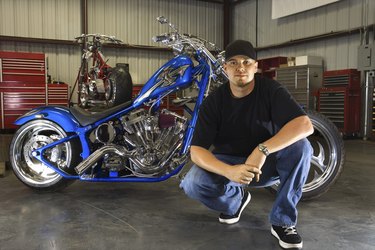
Motorcycle transmissions share many common design features across the spectrum of manufacturers. With few exceptions, most are constant-mesh, manual transmissions that use a hand- or foot-actuated clutch. These common design features makes it possible to perform basic troubleshooting procedures to diagnose certain problems without disassembling the transmission. If the troubleshooting identifies an issue in the transmission, and you do not have the tools, resources and experience to rectify the problem, have a professional make the repair for you. It is very easy to leave out a spacer, or put a part in backwards if you are not familiar with the work, and any failure in the transmission can cause a dangerous riding condition if it should fail at speed. Make sure that your transmission lubricant is fresh and in good shape before troubleshooting to avoid creating or exacerbating the symptoms.
Shift Mechanism Problems
The shift mechanism translates shift lever motion into shift slider motion within the transmission. Typically, the shift mechanism is a spring loaded cam- or drum-shaped device that actuates the sliders via the shift forks. Friction caused by wear, damage or corrosion can cause problems shifting, such as hard shifts, an inability to locate the neutral detent and in the worst cases, failure to shift at all. A bad shift mechanism will manifest itself with these symptoms. You will feel them through your shift lever. The shifter pawl return springs can fail, leading to a limp shift lever and a temperamental or non-functioning shifter.
Dogs, Pockets, Shift Forks and Sliders
The shift forks connect the shift mechanism to the sliders. A bent shift fork will cause its corresponding slider-gear cluster to bind in one gear, and then have insufficient dog-to-pocket engagement in the other gear in the cluster, with the other gears functioning as expected. Wear in the dogs and pockets will allow the slider to engage, but can allow it to pop out of gear when subjected to the heavy loads of rapid acceleration or compression braking. Indecisive shifting, a worn shift mechanism, bent or worn forks and worn gear spacers can cause wear in the dogs and pockets. If you determine that your dogs and pockets are worn, then you need to modify your shifting technique or look at the other aforementioned components to prevent further damage.
Gears and Bearings
Sound diagnosis can help determine if the bearings or gears are worn beyond service specs. As the gears wear, the space between the teeth, or gear lash, increases. If the gear lash becomes excessive, you will hear gear-clashing sounds, particularly on shifts and when initially releasing the clutch, or as the momentum shifts during compression braking.
Bad bearings, on the other hand, will produce a growling noise when the transmission is turning. You can tell which bearing is bad by the other conditions present when you hear the sound. If you hear it when the clutch lever is out, but the transmission is in neutral, then one of the mainshaft bearings is bad. If you hear the noise only when the transmission is in gear with the clutch out, then one of the countershaft bearings is bad. If you hear the noise all the time, regardless of the clutch position with the engine running, then the clutch hub bearing is damaged. Bikes equipped with a primary drive chain between the engine output sprocket and the clutch hub can make this noise if the chain is set too tightly and loading up the clutch hub bearing. Be sure to check the chain tensioner setting as per your manufacturer's instructions before tearing it apart to inspect the clutch hub bearing.
Other Considerations
Certain other conditions can cause the same symptoms as the previously described problems. For instance, clutch drag can cause harsh shifting and excessive gear clash. The solution for this may be as simple as a bad clutch or clutch cable adjustment, or it could be contamination of the clutch plates. A bad throwout bearing can cause a high-pitched bearing howl when you pull in the clutch lever, but the transmission bearings are generally larger and will produce a lower-frequency sound than the tiny throwout bearing. Corrosion can form on the shafts and gears if a bike sits idle for extended periods. Usually this is a light scale at worst, caused by water vapor entering the transmission case through the atmospheric vent and settling on the transmission components that are above the level of the transmission lubricant. This scale can cause gear-meshing sounds, and mimic the problems caused by a bad shifter mechanism. These are all good places to consider inspecting or adjusting in the process of troubleshooting your transmission.